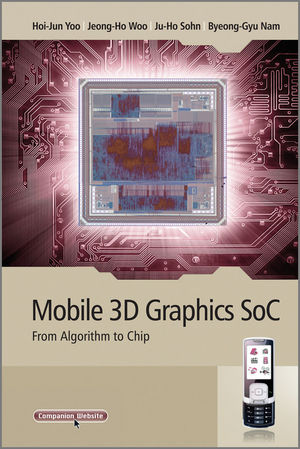Mobile 3D Graphics SoC: From Algorithm to ChipISBN: 978-0-470-82377-4
Hardcover
352 pages
March 2010, Wiley-IEEE Press
 This is a Print-on-Demand title. It will be printed specifically to fill your order. Please allow an additional 10-15 days delivery time. The book is not returnable.
|
||||||
1 Introduction.
1.1 Mobile 3D Graphics.
1.2 Mobile Devices and Design Challenges.
1.2.1 Mobile Computing Power.
1.2.2 Mobile Display Devices.
1.2.3 Design Challenges.
1.3 Introduction to SoC Design.
1.4 About this Book.
2 Application Platform.
2.1 SoC Design Paradigms.
2.1.1 Platform and Set-based Design.
2.1.2 Modeling: Memory and Operations.
2.2 System Architecture.
2.2.1 Reference Machine and API.
2.2.2 Communication Architecture Design.
2.2.3 System Analysis.
2.3 Low-power SoC Design.
2.3.1 CMOS Circuit-level Low-power Design.
2.3.2 Architecture-level Low-power Design.
2.3.3 System-level Low-power Design.
2.4 Network-on-Chip based SoC.
2.4.1 Network-on-Chip Basics.
2.4.2 NoC Design Considerations.
2.4.3 Case Studies of Chip Implementation.
3 Introduction to 3D Graphics.
3.1 The 3D Graphics Pipeline.
3.1.1 The Application Stage.
3.1.2 The Geometry Stage.
3.1.3 The Rendering Stage.
3.2 Programmable 3D Graphics.
3.2.1 Programmable Graphics Pipeline.
3.2.2 Shader Models.
4 Mobile 3D Graphics.
4.1 Principles of Mobile 3D Graphics.
4.1.1 Application Challenges.
4.1.2 Design Principles.
4.2 Mobile 3D Graphics APIs.
4.2.1 KAIST MobileGL.
4.2.2 Khronos OpenGL-ES.
4.2.3 Microsoft’s Direct3D-Mobile.
4.3 Summary and Future Directions.
5 Mobile 3D Graphics SoC.
5.1 Low-power Rendering Processor.
5.1.1 Early Depth Test.
5.1.2 Logarithmic Datapaths.
5.1.3 Low-power Texture Unit.
5.1.4 Tile-based Rendering.
5.1.5 Texture Compression.
5.1.6 Texture Filtering and Anti-aliasing.
5.2 Low-power Shader.
5.2.1 Vertex Cache.
5.2.2 Low-power Register File.
5.2.3 Mobile Unified Shader.
6 Real Chip Implementations.
6.1 KAIST RAMP Architecture.
6.1.1 RAMP-IV.
6.1.2 RAMP-V.
6.1.3 RAMP-VI.
6.1.4 RAMP-VII.
6.2 Industry Architecture.
6.2.1 nVidia Mobile GPU – SC10 and Tegra.
6.2.2 Sony PSP.
6.2.3 Imagination Technology MBX/SGX.
7 Low-power Rasterizer Design.
7.1 Target System Architecture.
7.2 Summary of Performance and Features.
7.3 Block Diagram of the Rasterizer.
7.4 Instruction Set Architecture (ISA).
7.5 Detailed Design with Register Transfer Level Code.
7.5.1 Rasterization Top Block.
7.5.2 Pipeline Architecture.
7.5.3 Main Controller Design.
7.5.4 Rasterization Core Unit.
8 The Future of Mobile 3D Graphics.
8.1 Game and Mapping Applications Involving Networking.
8.2 Moves Towards More User-centered Applications.
8.3 Final Remarks.
Appendix Verilog HDL Design.
A.1 Introduction to Verilog Design.
A.2 Design Level.
A.2.1 Behavior Level.
A.2.2 Register Transfer Level.
A.2.3 Gate Level.
A.3 Design Flow.
A.3.1 Specification.
A.3.2 High-level Design.
A.3.3 Low-level Design.
A.3.4 RTL Coding.
A.3.5 Simulation.
A.3.6 Synthesis.
A.3.7 Placement and Routing.
A.4 Verilog Syntax.
A.4.1 Modules.
A.4.2 Logic Values and Numbers.
A.4.3 Data Types.
A.4.4 Operators.
A.4.5 Assignment.
A.4.6 Ports and Connections.
A.4.7 Expressions.
A.4.8 Instantiation.
A.4.9 Miscellaneous.
A.5 Example of Four-bit Adder with Zero Detection.
A.6 Synthesis Scripts.
Glossaries.
Index.



